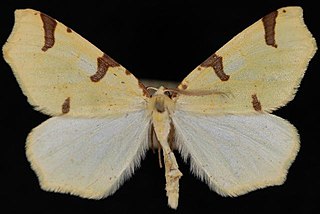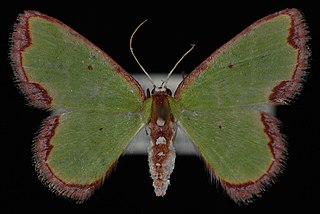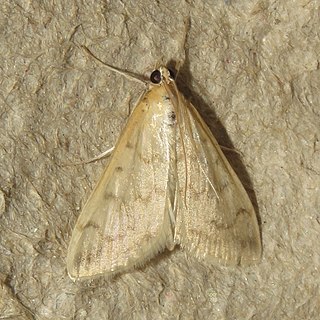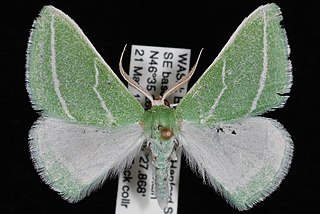
Digrammia was a genus of moths in the family Geometridae erected by Carl Freiherr von Gumppenberg in 1887. It is now often considered a synonym of Semiothisa.

Nemoria is a genus of emerald moths in the family Geometridae. It was named by Jacob Hübner in 1818.

Neoterpes is a genus of moths in the family Geometridae described by George Duryea Hulst in 1896.

Pero is a genus of moths in the family Geometridae erected by Gottlieb August Wilhelm Herrich-Schäffer in 1855.

Synchlora is a genus of moths in the family Geometridae erected by Achille Guenée in 1857.
Idia immaculalis, the immaculate idia, is a litter moth of the family Erebidae. The species was first described by George Duryea Hulst in 1886. It is found in North America from at least California, north and east across Montana to southern Alberta and Saskatchewan.

Monoptilota is a genus of snout moths. It was described by George Duryea Hulst in 1900. It contains only one species, the lima-bean vine borer moth, which is found in the central and south-eastern parts of the United States.
Acallis gripalis is a species of snout moth in the genus Acallis. It was described by George Duryea Hulst in 1886. It is found in North America, including Colorado, British Columbia, California and Arizona.

Synchlora aerata, the wavy-lined emerald moth or camouflaged looper, is a species of moth of the family Geometridae. The species was described by Johan Christian Fabricius in 1798. It is found in most of North America.
Cactobrosis fernaldialis, the blue cactus borer, is a species of snout moth in the genus Cactobrosis. It was described by George Duryea Hulst in 1886, and is found from Texas to southern California, where it inhabits deserts.

Sciota is a genus of snout moths. It was described by George Duryea Hulst in 1888.

Synchlora herbaria is a moth in the family Geometridae first described by Johan Christian Fabricius in 1794. It is found in Florida, Cuba, Hispaniola, Puerto Rico, the Bahamas, Antigua, Dominica and the Virgin Islands.

Synchlora cupedinaria is a moth in the family Geometridae first described by Augustus Radcliffe Grote in 1880. It is found in Florida, the Bahamas, the Virgin Islands, Guadeloupe, Martinique and possibly St. Kitts and Puerto Rico.
Abegesta reluctalis is a moth in the family Crambidae. It was described by George Duryea Hulst in 1886. It is found in North America, where it has been recorded from Arizona, California, Maryland and New Mexico.
Anania labeculalis is a moth in the family Crambidae. It was described by George Duryea Hulst in 1886. It is found in North America, where it has been recorded from Arizona to western Texas.

Hahncappsia pergilvalis is a moth in the family Crambidae. It was described by George Duryea Hulst in 1886. It is found in North America, where it has been recorded from Ontario and the north-eastern and south-western United States. It is also present in Mexico, where it has been recorded from the Federal District, Puebla and Jalisco.
Saucrobotys fumoferalis, the dusky saucrobotys moth, is a moth in the family Crambidae. It was described by George Duryea Hulst in 1886. It is found in North America, where it has been recorded from Nova Scotia west to British Columbia, north to Yukon, and south to Pennsylvania, Illinois and California. The habitat consists of boreal forests, mixed forests and woodlots.

Chloropteryx tepperaria, the angle-winged emerald moth, is a moth of the family Geometridae. The species was first described by George Duryea Hulst in 1886 and it is found in the southeastern United States.
Choristostigma roseopennalis is a moth in the family Crambidae. It was described by George Duryea Hulst in 1886. It is found in Mexico and the United States, where it has been recorded from Arizona, Georgia, Indiana, Maryland, North Carolina, Ohio, Tennessee and Texas.

Synchlora bistriaria, the oblique-striped emerald, is a species of emerald moth in the family Geometridae.














